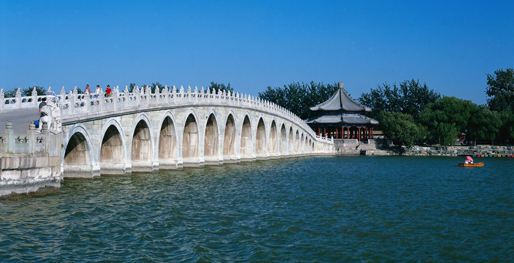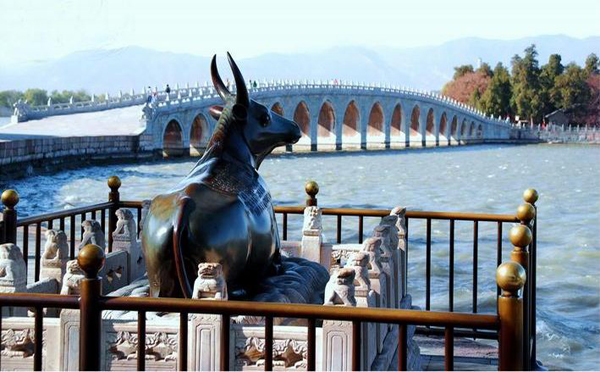 |
|
The Seventeen-Arch Bridge in the Summer Palace
|
Located in the Summer Palace, on the east bank of Kunming Lake, near the Seventeen-Arch Bridge, visitors can see a life-sized bronze ox. The Bronze Ox sitting beside the water and overlooking the mountain and lake, is imposing. It is said that the ox was made two hundred years ago when Emperor Qianlong (1711-1799), the fourth emperor of the Qing Dynasty (1368-1644), ordered to rebuild the Summer Palace.
In ancient China, copper used to be compared to gold because of their similar color. Therefore, many people have called this bronze ox “Golden Ox.” The Emperor Qianlong even personally dedicated the bronze ox. On the back of the ox is an 80-character-posy in seal character, 'Golden Ox Inscription' by him.
 |
|
The Bronze Ox
|
Why did Emperor Qianlong want to create a giant ox next to Kunming Lake? There are several explanations for its origin.
First, the Bronze Ox is said to possess flood control powers. Emperor Qianlong placed it at the bank of the lake in hopes that it could restrain a potential flood brought by Kunming Lake, and bring infinite blessings to both the garden and the nearby dwellers.
Second, it is said that another use was to monitor the water level. The groundwork of Kunming Lake's east bank was built 10 meters higher than the Forbidden City. The bursting of the east bank would place the Forbidden City in danger. So for the convenience of water level observation, the ox was placed there.
The third theory says that according to Chinese legend “Niulang (cowboy) and Zhinu (weaver girl),” the emperor built this Bronze Ox to symbolize the two. Near the Jade Belt Bridge on the western shore of Kunming Lake, there is a village named “Geng Zhi Yuan” (farming and weaving in this garden). Several mulberry trees were planted in this village. About 200 years ago, people happily lived there, planted mulberry trees, raised silkworms and wove. On the other hand, as in the east coast of the Kunming Lake there is a Bronze Ox, so people took the former as a sign of the weaver girl, and the latter symbolizes the cowboy.
We recommend:
